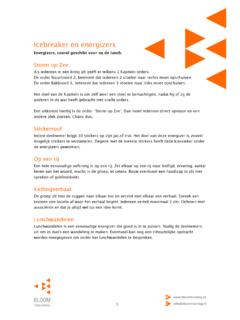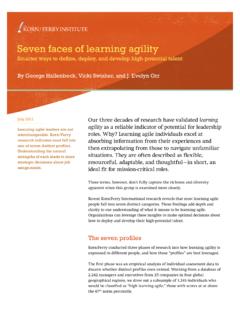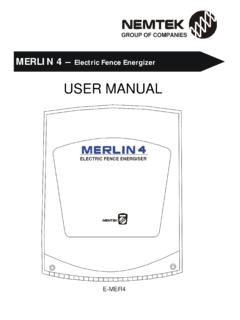Transcription of SAMPLE ENERGIZERS - KASC.NET
1 SAMPLE ENERGIZERS . Get Participants Moving! Why? 1) One type of memory storage is called procedural learning and this kind of knowledge is stored in the body. An example of this would be when you don't know a phone number unless you dial it. Learning through movement gives people another way to aid memory. 2) Attitude is an important factor for motivation to learn movement helps put adults (and students) in a positive state of mind. 3) Our brains require a lot of oxygen and more movement helps bring in fresh oxygen. 4) Our brains don't distinguish between the body and the brain, so if our body is uncomfortable it hurts learning. 5) You are modeling good classroom practice! If possible you want people up and moving in some way about every 30 minutes or so. (If adapting this to a classroom it would need to be more often for younger students.) The movement can be part of the teaching and learning like the activities below. It doesn't take very long even a couple of minutes of movement will raise the energy level.
2 Opening ENERGIZERS Pose the question: How are you going to achieve proficiency by 2014? . After listening to a few answers have the participants do the following activity: 1) Ask the participants to pretend that the room represents a scale of 1 to 10 with the right hand side of the room representing 1 or very low and the right hand side representing 10 or very high. 2) Ask the participants to stand and move to a place in the room that represents their energy level at that moment (depending on the response, make a comment or two to acknowledge how they are feeling). 3) Now ask the participants to be very honest and move to the area that represents their level of expectation about this workshop (again acknowledge how they are feeling (without judgment!). 4) Ask the participants to be very honest with themselves and to now move to the area of the room that represents their willingness to be open to new ideas. (Doing this with a close-knit faculty should actually invoke a bit of fun with their comments to each other on where they should stand!
3 5) Tell the participants that their willingness to be open to new ideas and strategies is one of the first steps to reaching the proficiency goal of 100 that you spoke of earlier. 6) Lastly have everyone move to the area of the room that represents their willingness to make changes in their behavior when it makes sense for them to do so. Now tell them that this is the second thing that will help them to reach their goal. You will probably get some good discussion about this part. ENERGIZERS That Are Also Review Activities NOTE: To have ENERGIZERS work well you should always: v Give directions one at a time. v Be sure there is some physical movement. You can have participants walk briskly to find a partner or group and then do a return walk when the activity is over, or in place of walking you could add in some crossovers, stretches, calf raises, etc. v Have participants thank the partner or group when the activity is over. Pass It On Ask participants to move at least 10 brisk steps.
4 Have them form groups of 4-5 people. Write a review topic and unfinished sentence up on the board. For example, Topic: One important thing I've learned about how students learn is Ask one participant in each group to complete the sentence and then it's the next person in the group's turn to say something new. The goal is to continue contributing to the review as long as possible. When each person has been able to add at least one thing, call the activity to a close. Tell participants to thank their group members, then take at least 10 steps as they walk back to their seats. Walk and Review Give the learners a question or two for review. For example: Explain to your partner about one of Marzano's effective instructional strategies, or Explain to your partner two responsibilities that school council members have. Have learners choose a partner and go for a short walk while they discuss their topic. (Designate a time.) Suggest an area that is suitable for walking and would allow them to really move.
5 Reporter Review Divide the group in half with one half representing the experts and the other half representing the reporters. Ask participants to move at least 10 brisk steps and each reporter needs to find an expert. The reporters' job is to interview the experts on the present topic of study. Give them five minutes to get the story, then call on each reporter to add a point to the review chart. When that is done, tell participants to thank their partners, then take at least 10 steps as they walk back to their seats. This should be a very fast activity 2 minutes for the interviews, 2. minutes for the review chart, and a minute for travel time. Roller Derby Review With music playing in the background, have participants stand up and walk fast around the entire room like a roller derby to increase circulation. Ask them to think of two to five key words discussed in the last twenty minutes. Then have them share their words with five other people. Musical Chairs Have a group form a circle with chairs facing inward.
6 The leader manages the music, while the group circles around the chairs. When the music stops, everyone must find a chair, but one has been removed. The person left standing must share one thing they've learned related to the present topic of study. Instead of disqualifying this player, however, continue the game until a variety of people have shared what they know. Instant Replay Do you want to stress an important concept or point? Stop and tell participants to stand and partner with the person next to them. Reiterate the point you were making and ask that one of the participants acts that point out and the partner replays it. You can add time restraints, specify sounds or no sounds, words or no words, etc. This can also be used as review as you have the participants perform their replays to start things up again after a break. Teach Someone Else In small groups have learners translate the present topic of study into a lesson that five-year- olds (or six-year-olds, seven-year-olds, etc.)
7 Would be able to understand. This is a great strategy to ensure everyone understands the basic concepts. Simple Ways to Energize and Refresh These activities aren't designed to relate directly to the content, but just provide a short break to get participants energized and ready to learn again. General Energizer Moves v Have participants stand up and stretch as high as they can. Then have them reach for their toes. Repeat a few times. v Have participants do 10 jumping jacks or march in place for a count of 50. v Have participants rise up and down on their toes to stretch calf muscles and get blood flowing. Crossovers Anytime the arms or legs crossover the middle of the body the brain wakes up, because the left side of the brain controls the right part of the body and vice versa. Crossovers are a wonderful way to create some energy. Have participants stand up and start with alternating touching each shoulder with the opposite hand. From there you can do opposite hands to raised knees and then opposite hands in the back of the body to touch a raised foot.
8 Any movement that crosses over the body will work. You can also do the grapevine if you know that exercise move, the old windmill stretches, or create a hand clap/slap pattern like those chants children do. Lazy 8's Have participants hold the thumb at eye level straight out in front of the body. Instruct them to stare at the thumb and without moving their heads to have their eyes follow the thumb as it traces a huge lazy figure eight (infinity symbol) in the air. Do 2-3 with each hand. Then have them clasp both hands together and do the same thing to the right and then to the left. This also wakes the brain up and prepares it for learning. Catch It Have four participants stand forming a square where each person is facing inside the square. (A triangle will work too.) Next they put out both of their hands with palms up and elbows by their waists. Instruct each person to take his/her right index finger and point it up to the sky. Next, the index finger gets put down into the palm of the person next to them.
9 The facilitator counts 1 2 3 and on 3, each person tries to catch the index finger of the neighbor while trying to keep his/her own index finger from being caught. Repeat with right finger and then switch to the left finger for two tries. This activates the brain because it has to do two things at one time, plus it makes everyone laugh and that is a great way to wake up the brain. Getting to Know You Break You can be the leader or let a participant be the leader. The leader completes the sentence Meet Three People Who and adds in a characteristic, such as are wearing blue', or has more hair on their head than you do', or has an A in their name'. The participants walk around the room and shake hands with the people who fit the category. Fresh Start To keep the room novel and the learners' perspective fresh, have everyone stand up and find a seat on the opposite side of the room. A variation on this is to have everyone push his or her desks or chairs into a new position ( , a large circle, theater style, etc.)
10 Calming Down after Movement Deep Breathing If participants need help calming down after a movement activity or an energizer, make it part of your routine that the whole group takes five deep breathes together before returning to work. Bunny Breathing This is an alternative to deep breathing, but serves much the same purpose, plus is supposed to be a cleansing process to make sure fresh oxygen is getting to the brain. Have participants take three short, quick breathes in through their nose, then a long exhale out of their mouth. Repeat about five times. The Thinking Cap Have participants grasp the top of their outer ear with thumb and index finger. They should unroll ear from the top to bottom using gentle squeezing motions. Repeat 3-4 times. This comes from the book Brain Gym and is one of the ways to get the brain focused and ready to concentrate. Brain Buttons This clears the brain and helps ready it for learning by getting blood to the brain. Tell participants to use the thumb and index finger of one hand and follow the large muscles down until reaching the collarbone.






